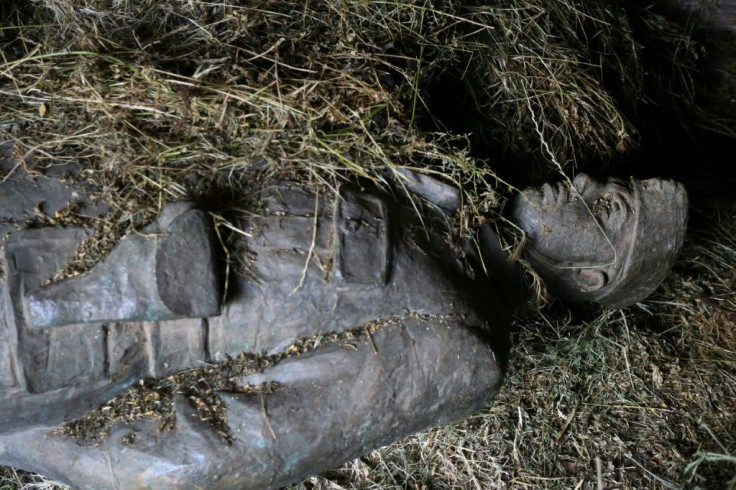One Family's Vigil To Protect The Memory Of Albania's Dictator
Sabire Plaku gets short of breath when she climbs the hill that leads to the last intact statue of Albania's communist former dictator Enver Hoxha.
Every morning, the 85-year-old checks that nobody has touched the effigy, which depicts him as a warrior.
Hoxha ruled with an iron fist for 45 years until his death in 1985, persecuting and executing many thousands.
When the communist regime fell six years after his death, dozens of Hoxha's statues did not survive the anger of his countrymen.
In Labinot Mal, a village nestled in mountains in central Albania, the more than two metres (6.6 feet) tall bronze effigy remains intact and hidden, thanks to the efforts of Plaku and other villagers who want to protect a "hero" of the nation.
The village plays host to a vital part of Albania's history -- Hoxha installed the headquarters of the National Liberation Army in a huge stone house there in June 1943, during the fight against Italian fascists and German Nazi occupiers.

The invaders were driven out of Albania shortly after, and the communist regime later transformed the house into a military museum.
However, it is now a shadow of its former self.
Moisture drips down its walls and the roof is on the brink of collapse. Everyone has abandoned it -- except Plaku and her family.
Every day, she breathlessly climbs the hill and stairs leading to the house.
Once there, she will carefully clean the statue of the dictator, hidden under straw in a stable on the ground floor that the sun barely reaches.

"It is invisible but not absent," said Plaku, so fragile that she can barely open the dilapidated door secured with an iron bar.
"I've been guarding him for years, since the fall of the regime," she said, referring to the events of April 1991.
At the time, dozens of people used ropes to tear out the statue from its stone pedestal next to the museum.
The museum itself, displaying the dictator's weapons, photos and bed, was robbed.
To protect the statue from the victims of Hoxha's regime -- as well as scrap dealers -- "we hid it here, under straw", Plaku said.
She is cautious and distrusts strangers visiting the village, accessible by a bad mountain road from Elbasan, the nearest town some 30 kilometres (19 miles) away.

But taking care of the statute is getting more difficult for Plaku.
"We do what we can, the strength abandons us," she sighed.
"The authorities must find a solution," said her 60-year-old daughter Fatush Balla.
The village remains divided over the issue.
Sheqet Burraj is among those who think the museum should be reopened and the statue removed from its hiding place.
This would not "praise the merits" of the dictator, says Burraj, but it would help Albanians to understand the past and attract visitors.
In the capital Tirana, where tens of thousands of demonstrators pulled down a statue of Hoxha in February 1991, little remains of the dictator.
However, sculptor Muntaz Dhrami does have one memento -- pieces of an 80-tonne effigy in grey marble that he keeps in his studio in Tirana.
He made it in 1988 in Gjirokaster, Hoxha's birthplace.
With the collapse of the communist regime, the statue became the victim of people's rage, Dhrami recalled.
"They broke its nose, hand, decapitated it, the head was transported to Tirana to be demolished."
From the statue he now has only two ends of a collar and a piece of a foot.
"I did not create the dictator, I created a work of art," said Dhrami, 84.
The only other trace of Hoxha still visible in Tirana is the head of a statue, abandoned behind an art gallery.
It is placed just next to statues of Soviet leaders Lenin and Stalin.
One of the statues had been given to Hoxha by his wife Nexhmije, knowing he was a great admirer of the Soviet leaders.
Former communist countries across the world have had to reckon with the legacy of totalitarianism. Some have tried to erase the past, others glorify it and still others memorialise it.
Albania has yet to choose a clear path.
© Copyright AFP 2024. All rights reserved.





















